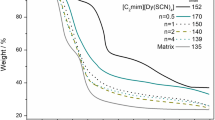Abstract
We investigate the room temperature frequency dependence of electrical modulus for the polymer electrolytes consisting of chitosan and oxalic acid in the frequency range from 50 Hz to 1 MHz. Oxalic acid serves as the proton provider. It is found that the lowest imaginary electrical modulus is shown by the highest conducting sample OA40, which contains 60 wt.% chitosan and 40 wt.% oxalic acid. The electrical moduli for OA40 sample membrane at different temperatures are also studied, and the peak of the imaginary electrical modulus has been observed to shift towards higher frequency with increasing temperature. This indicates that relaxation is thermally assisted. Analysis of electrical modulus shows that the main relaxation process in chitosan–oxalic acid polymer electrolyte system is a non-Debye process associated with viscoelastic relaxation.










Similar content being viewed by others
References
Ravi Kumar MNV (2000) React Funct Polym 46:1–27
Mukoma P, Jooste BR, Vosloo HCMJ (2004) J Power Sources 136:16–23
Smitha B, Anjali Devi D, Sridhar S (2008) Int J Hydrog Energy 33:4138–4146
Ng LS, Mohamad AA (2008) J Membr Sci 325:653–657
Arof AK, Osman Z, Morni NM, Kamarulzaman N, Ibrahim ZA, Muhamad MR (2001) J Membr Sci 36:791–783
Boroglu MS, Celik SU, Bozkurt A, Boz I (2011) J Membr Sci 375:157–164
Goktepe F, Celik SU, Bozkurt A (2008) J Non-Cryst Solids 354:3637–3642
Mohamed NS, Subban RHY, Arof AK (1995) J Power Sources 56:153–156
Morni NM, Arof AK (1999) J Power Sources 77:42–48
Morni NM, Mohamed NS, Arof AK (1997) Mater Sci Eng B 45:140–146
Subban RHY, Arof AK, Radhakrishna S (1996) Mater Sci Eng B 38:156
Ng LS, Mohamad AA (2006) J Power Sources 163:382–385
Tangaris GM, Psarras GC, Kouloumbi N (1998) J Mater Sci 33:2027–2037
Woo HJ, Majid SR, Arof AK (2012) Mater Chem Phys 134:755–761
Belattar J, Achour ME, Brosseau C (2011) J Appl Phys 110(054101):1–7
Cosgun S, Celik SU, Baykal A, Bozkurt A (2010) Curr Appl Phys 10:133–137
Dziaugys A, Banys J, Samulionis V, Vysochanskii Y (2008) Ultragarsas 63:7–10
Greicius S, Banys J, Szafraniak-Wiza I (2009) Process Appl Ceram 3:85–87
Diaz Calleja R, Matveeva ES, Parkhutik VP (1995) J Non-Cryst Solids 180:260–265
Ai L, Jiang J, Li L (2010) J Mater Sci 21:206–210
Dasari MP, Sambasiva Rao K, Krishna PM, Krishna GG (2011) Acta Phys Pol A 119:387–394
Mohomed K, Gerasimov TG, Moussy F, Harmon JP (2005) Polymer 46:3847–3855
El-Nahass MM, Farid AM, Abd El-Rahman KF, Ali HAM (2008) Phys B 403:2331–1337
Choi B-K, Kim Y-W (2004) Electrochim Acta 49:2307–2313
Cheruku R, Govindaraj LG (2012) Mater Sci Eng B 177:771–779
Lopes AC, Costa CM, Sabater i Serra R, Neves IC, Gomez Ribelles JL, Lanceros-Mendez S (2013) Solid State Ionics 235:42–50
Pradhan DK, Choudhary RNP, Samataray BK (2008) Express Polym Lett 2:630–638
Psarras GC, Gatos KG, Karahaliou PK, Georga SN, Krontiras CA, Karger-Kocsis J (2007) Express Polym Lett 1:837–845
Pissis P, Kyritsis A (1997) Solid State Ionics 97:105–113
Krishnakumar V, Shanmugam G (2012) Ionics 18:403–411
Ayesh AS (2009) Polym J 41:616–621
Ambrus JH, Moynihan CT, Macedo CB (1972) J Phys Chem 76:32873295
Money BK, Hariharan K, Swenson J (2012) J Phys Chem B 116:7762–7770
Acknowledgments
The authors would like to express gratitude to University Malaya for research grant PV059-2012A (PPP Grant) and FP035-2012A. The authors also would like to express heartfelt gratitude to Ms. Leeana Ismail for her assistance in this paper.
Author information
Authors and Affiliations
Corresponding author
Rights and permissions
About this article
Cite this article
Fadzallah, I.A., Majid, S.R., Careem, M.A. et al. Relaxation process in chitosan–oxalic acid solid polymer electrolytes. Ionics 20, 969–975 (2014). https://doi.org/10.1007/s11581-013-1058-z
Received:
Revised:
Accepted:
Published:
Issue Date:
DOI: https://doi.org/10.1007/s11581-013-1058-z




